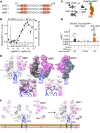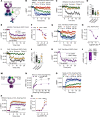Neuropilin-1 inhibition suppresses nerve growth factor signaling and nociception in pain models
- PMID: 39589827
- PMCID: PMC11827847
- DOI: 10.1172/JCI183873
Neuropilin-1 inhibition suppresses nerve growth factor signaling and nociception in pain models
Abstract
Nerve growth factor (NGF) monoclonal antibodies inhibit chronic pain, yet failed to gain approval due to worsened joint damage in osteoarthritis patients. We report that neuropilin-1 (NRP1) is a coreceptor for NGF and tropomyosin-related kinase A (TrkA) pain signaling. NRP1 was coexpressed with TrkA in human and mouse nociceptors. NRP1 inhibitors suppressed NGF-stimulated excitation of human and mouse nociceptors and NGF-evoked nociception in mice. NRP1 knockdown inhibited NGF/TrkA signaling, whereas NRP1 overexpression enhanced signaling. NGF bound NRP1 with high affinity and interacted with and chaperoned TrkA from the biosynthetic pathway to the plasma membrane and endosomes, enhancing TrkA signaling. Molecular modeling suggested that the C-terminal R/KXXR/K NGF motif interacts with the extracellular "b" NRP1 domain within a plasma membrane NGF/TrkA/NRP1 of 2:2:2 stoichiometry. G α interacting protein C-terminus 1 (GIPC1), which scaffolds NRP1 and TrkA to myosin VI, colocalized in nociceptors with NRP1/TrkA. GIPC1 knockdown abrogated NGF-evoked excitation of nociceptors and pain-like behavior. Thus, NRP1 is a nociceptor-enriched coreceptor that facilitates NGF/TrkA pain signaling. NRP binds NGF and chaperones TrkA to the plasma membrane and signaling endosomes via the GIPC1 adaptor. NRP1 and GIPC1 antagonism in nociceptors offers a long-awaited nonopioid alternative to systemic antibody NGF sequestration for the treatment of chronic pain.
Keywords: Cell biology; Neuroscience; Pain; Signal transduction.
Conflict of interest statement
Figures










Comment in
- Reinvigorating drug development around NGF signaling for pain
References
MeSH terms
Substances
Grants and funding
LinkOut - more resources
Full Text Sources
Miscellaneous

